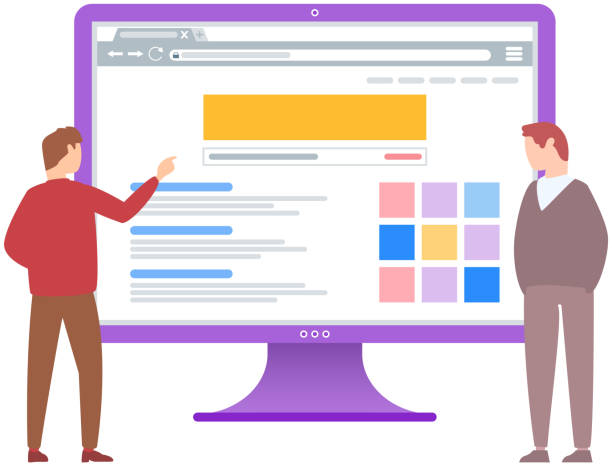The Vital Role of Modern User Interface in Online Success
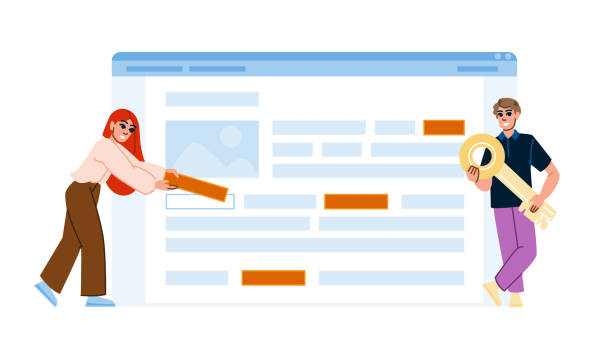
In the current era, where the internet has become an inseparable part of daily life, a strong and effective online presence is vital for every business and individual.
One of the most important factors for success in the digital space is the website’s user experience (UX) and user interface (UI).
Modern UI website design is no longer a luxury option but a necessity for survival and competitiveness.
This type of design, beyond mere aesthetics, means creating a user-friendly, intuitive, and engaging digital environment that encourages users to interact more and achieve their goals.
A modern user interface shapes the user’s first #impression of your brand and can be the difference between a fleeting visitor and a loyal customer.
When a user enters a website, they decide in a fraction of a second whether to stay or leave.
This decision is heavily influenced by the #UI_design and #ease_of_use of the website.
An old, complex, or unintuitive user interface can lead to a high Bounce Rate and lost business opportunities.
In contrast, modern UI website design not only enhances visual appeal but also simplifies navigation processes and improves the overall user experience.
This design approach means deep attention to user needs and expectations, such that every design element is purposeful and carefully chosen.
In fact, the main goal is to create a smooth and enjoyable interaction between the user and the website, leading to increased satisfaction and loyalty.
This importance is so great that many leading companies allocate significant budgets to continuously improving their user interface and user experience.
Websites that are leaders in this field often see a significant increase in user engagement, conversion rates, and ultimately, their revenue.
Furthermore, a modern user interface plays a significant role in search engine optimization (SEO).
Search engines like Google rank websites that offer a better user experience higher.
High loading speed, responsiveness, responsive design, and easy navigation are among the factors considered by Google’s algorithms, all of which are part of a modern and efficient user interface design.
Therefore, investing in modern UI website design is an investment in the future of your online business.
This helps you not only attract more audiences but also retain them and turn them into loyal customers.
This type of design helps your website stand out among countless competitors and creates a strong and memorable visual identity for your brand.
This includes not only visual aesthetics but also flawless performance and accessibility for all users, regardless of their device or abilities.
Are you concerned that your company’s old website is driving away new customers? RasaWeb solves this problem with modern and efficient corporate website design.
✅ Increases your brand’s credibility.
✅ Helps attract targeted customers.
⚡ Contact RasaWeb for a free consultation!
Fundamental Principles of UX/UI Design for Leading Websites

To achieve a modern and effective #web_design, familiarity with the fundamental principles of UX/UI is essential.
These principles guide designers to create a product that not only looks beautiful but also has high functionality and meets user needs.
The first and most important principle is #user_centricity; meaning all design decisions must be made considering the needs, behaviors, and goals of the users.
This includes in-depth research on the target audience, creating personas and user scenarios to better understand the customer journey.
Also, the principle of simplicity and clarity is of great importance in design.
The user interface should not be complex or confusing.
Information should be easily understandable, and navigation paths should be clear and logical so users can easily reach their goals.
Clutter and superfluous information should be avoided, and the focus should be on providing relevant and essential content.
Another key principle in modern UI website design is #empathy and #consistent_experience.
Users expect similar elements to function uniformly across all website pages and to follow standard design patterns.
This allows users to interact easily with different parts of the website without needing to relearn.
Furthermore, providing appropriate feedback to the user, such as showing loading status, confirming form submission, or displaying error messages, is of high importance.
These feedbacks assure the user that their actions have been recorded and are being processed.
Responsive Design is also a vital principle.
Given the variety of devices (desktop, tablet, mobile) users employ to access websites, the user interface must be adaptable to different screen sizes and resolutions.
This ensures that the user experience is optimal and consistent across every device, without the need to develop separate versions for each platform.
Finally, #aesthetics and #visual_appeal are also part of the fundamental principles.
A beautiful and pleasing user interface can create a positive feeling in the user and encourage them to spend more time on the website.
This includes the intelligent use of colors, fonts, images, and whitespace to create visual balance and harmony.
However, beauty should not come at the expense of functionality.
A combination of beauty and optimal functionality forms the core of a successful UI/UX design.
Also, Accessibility means ensuring that the website is usable for everyone, including people with disabilities.
This includes providing alternative text for images, using appropriate color contrast, and keyboard navigation.
In summary, adhering to these principles helps you deliver a modern UI website design that not only meets your business needs but also creates an unforgettable experience for users and turns them into loyal customers.
Modern Tools and Techniques in Modern UI Website Design

To implement a modern and efficient #web_design, designers and developers use a set of advanced tools and techniques.
These tools help them optimize the design process and deliver high-quality results.
In the design and prototyping phase, tools such as Figma, Adobe XD, and Sketch are highly popular.
These software applications enable UI design, wireframing, prototyping, and simultaneous team collaboration.
The sharing and feedback capabilities in these tools allow teams to quickly iterate and improve ideas.
The use of Design Systems is also an important technique that helps maintain consistency and coherence in the design of large websites.
These systems include a collection of components, patterns, visual guidelines, and design principles that enable teams to work with greater speed and accuracy and prevent inconsistencies in the user interface.
In the development and implementation phase, modern #frontend_frameworks like React, Vue.js, and Angular play a vital role in creating dynamic and interactive user interfaces.
By providing a component-based structure, these frameworks enable developers to create different parts of the user interface in a modular and reusable way.
This not only increases development speed but also improves code maintainability and scalability.
Also, using CSS libraries like Tailwind CSS or Bootstrap speeds up the styling process and enables the creation of responsive and beautiful designs.
Animations and Micro-interactions are also important techniques that help improve the user experience and increase visual appeal.
Subtle animations when clicking buttons, loading content, or navigating can convey a sense of dynamism and pleasure to the user.
Furthermore, advanced techniques such as #responsive_typography, the use of SVG for scalable vector graphics, and the implementation of Dark Mode to increase visual comfort for users in low-light environments are among the considerations in modern UI website design.
Usability Testing and A/B testing are also important tools that allow designers to measure the effectiveness of their designs in the real world and achieve necessary improvements by gathering feedback from real users.
| Feature / Tool | Figma | Adobe XD | Sketch |
|---|---|---|---|
| Collaborative Work | Excellent (web-based) | Good (app with cloud capabilities) | Average (limited plugins) |
| Prototyping | Advanced | Advanced | Average (requires plugins) |
| Operating System | Cross-platform (web, desktop) | Windows, Mac | Mac only |
| Pricing | Freemium | Subscription (Creative Cloud) | License purchase |
| Code Export | Average (requires plugins) | Average (limited plugins) | Average (requires plugins) |
All these tools and techniques together help designers and developers create websites with an attractive, efficient, and up-to-date user interface.
In fact, mastering these tools and having a deep understanding of their application is an important step towards providing a modern UI website design that can significantly improve the user experience and contribute to the website’s business goals.
This specialized approach not only adds visual beauty but also contributes to the technical performance and overall optimization of the site.
The Impact of Modern User Interface Design on Audience Attraction and Conversion Rate
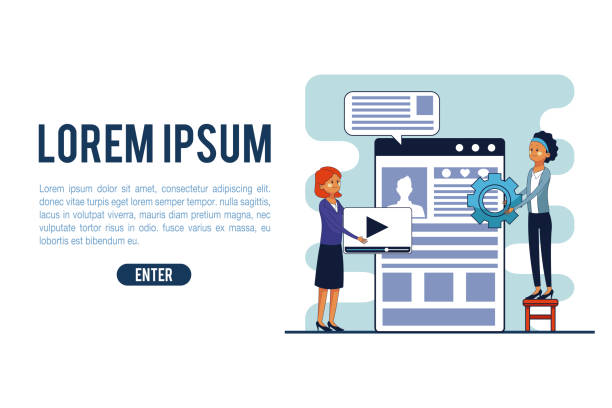
One of the most important goals of any website is to #attract_audiences and convert them into customers or active users.
#Modern_UI_design plays a pivotal role in achieving these goals.
A website with an old or inappropriate UI, even with excellent content, will face serious challenges in attracting and retaining audiences.
Today’s users, especially younger generations, have high expectations for websites.
They seek a smooth, engaging, and intuitive experience.
When a website meets these expectations, not only does the bounce rate decrease, but the user’s time spent on the site increases.
This increased engagement and retention sends positive signals to search engines and helps improve the site’s ranking in search results, which in turn leads to attracting more audiences.
The impact of modern UI website design on the #conversion_rate is very significant.
Conversion rate refers to the percentage of visitors who take a desired action, such as purchasing a product, filling out a contact form, subscribing to a newsletter, or downloading a file.
An effective UI/UX design simplifies conversion processes.
For example, the design of registration or payment forms should be such that they create minimal friction for the user.
Clear navigation and prominent, compelling Call to Action buttons guide the user towards the desired action.
Using psychological principles in design, such as scarcity or social proof, can increase the effectiveness of buttons and offers.
Furthermore, a modern user interface instills a sense of trust and credibility in users.
Websites that have a professional and up-to-date appearance are generally perceived as more trustworthy by users.
This trust, especially in e-commerce websites, is a key factor in purchasing decisions.
In today’s digital marketing, user experience is recognized as a significant competitive advantage.
Companies that invest in #user_experience_design and user interface not only attract more customers but also have a higher customer return rate.
Users are willing to pay more for a better experience or choose a specific brand.
Therefore, optimizing the user interface means optimizing for business success.
Analyzing user data, such as Heatmaps and Session Recordings, can provide valuable insights into user behavior and help designers identify and address UI weaknesses.
Ultimately, focusing on a modern UI website design means creating a smooth and enjoyable path for customers from the moment they enter the website until they take the desired action and become loyal brand advocates.
Are you concerned that your company’s old website is driving away new customers? RasaWeb solves this problem with modern and efficient corporate website design.
✅ Increases your brand’s credibility.
✅ Helps attract targeted customers.
⚡ Contact RasaWeb for a free consultation!
Common Mistakes in UI/UX Design and How to Avoid Them
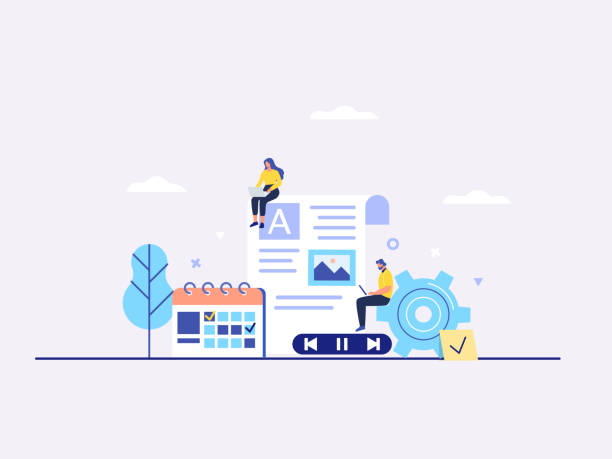
Even with the best intentions and advanced tools, designers can make mistakes that disrupt the user experience.
Understanding these #common_mistakes in #UI/UX_design and how to avoid them is essential for creating an effective modern UI website design.
One of the most common mistakes is over-complexity in design.
Some designers try to put all features and information on one page, leading to clutter and user confusion.
The solution to this problem is a minimalist approach, focusing on core content and simple navigation.
Every element should have a clear purpose and help the user achieve their goal.
Also, a lack of #visual_and_functional_consistency is a major mistake.
Using different fonts, colors, and styles across various pages, or changing button functionality, causes user confusion.
Ignoring #responsive_design or optimization for mobile devices is a glaring error that many websites make.
Given the significant increase in smartphone usage for internet access, a website that doesn’t display well on mobile loses a large portion of its audience.
It must be ensured that the website has appropriate functionality and appearance on all types of devices and screen sizes.
Another mistake is #lack_of_proper_user_feedback.
Users should always know where they are on the website, what they can do, and what the outcome of their actions has been.
Error messages should be clear, informative, and friendly, guiding the user in resolving the issue.
A modern UI website design must manage these interactions correctly.
Also, using #illegible_fonts or color combinations with low contrast can severely diminish the user experience.
Readability must be a priority so that content is easily understandable.
Designers must adhere to typography principles and use appropriate color palettes.
Failing to conduct #usability_testing with real users is also a common mistake.
Designers might assume they know how users will interact with their website, but reality is often different.
Usability testing with a sample of target users can reveal hidden problems and indicate opportunities for improvement.
Finally, simply copying competitors without understanding your own audience’s needs is also a wrong path.
Every website should have its unique identity and purpose.
By avoiding these mistakes and focusing on user-centered principles, one can create a successful modern UI website design that is valuable for both the business and its users.
The Future of Web User Interface Design: A Look at Upcoming Trends
![]()
The world of #web_design is rapidly changing, and new trends are constantly emerging that shape the future of #user_interface_design.
To remain competitive and deliver a modern UI website design, one must have a deep understanding of these upcoming trends.
One of the most important among them is #Artificial_Intelligence (AI) and Machine Learning, which are increasingly integrated into UI/UX design.
AI can play a role in user experience personalization, user behavior analysis, and even automating parts of the design process.
For example, AI-powered chatbots with more natural user interfaces can improve customer support.
Voice User Interface (VUI) is also gaining popularity.
With the widespread adoption of voice assistants like Siri, Alexa, and Google Assistant, website designs must support voice commands.
This is particularly important for user accessibility and convenience.
#Virtual_Reality (VR) and #Augmented_Reality (AR) also have great potential to revolutionize the web user experience.
Although still in early stages, imagine websites that allow viewing products in a 3D environment or virtually trying on clothes.
These technologies can offer a highly immersive and engaging experience.
#Micro-interactions and #advanced_animations are continually evolving.
These small but impactful elements, such as a button changing color on hover or visual feedback upon form submission, can make the user experience much more pleasant and dynamic.
The use of 3D Graphics and Morphic Design is also growing, which adds more depth and realism to the user interface.
Furthermore, with increasing public awareness about privacy, #Ethical_Design and transparency in user data usage are gaining more importance.
Websites should have user interfaces that give users more control over their data and inform them about how their information is being used.
All these trends indicate that the future of #website_design with #modern_user_interface is moving towards more personalized, intelligent, and interactive experiences, where individual user needs are increasingly considered, and the effort to create unparalleled digital experiences will continue.
Successful Examples of Modern UI Website Design and Their Lessons

Examining #successful_examples in the field of #modern_UI_website_design can be inspiring and teach valuable lessons to designers and businesses.
These websites are not only visually appealing but also offer an outstanding user experience that distinguishes them from competitors.
One prominent example is the Apple website.
Apple has set a standard in web design with its minimalist designs, abundant use of whitespace, high-quality images, and highly intuitive navigation.
The main lesson from Apple is the emphasis on simplicity and product focus.
Every element on the page has a clear purpose, and clutter and superfluous information are avoided.
The smooth user experience across the entire site, from tablet to desktop, is a masterpiece of responsive design.
Another example is Airbnb.
This platform revolutionized the travel and accommodation industry with its highly user-friendly interface.
Visual search design, large and high-quality images, and a simple booking process all contribute to an unparalleled user experience.
The lesson here is that strong #visual_content and #process_simplicity can significantly increase user engagement.
Airbnb, by providing advanced filters and interactive maps, allows users to quickly and easily find what they are looking for.
Also, news websites like The New York Times or platforms like Stripe (for online payments) are good examples of modern UI website design that, despite a large volume of information or complex processes, provide a simple, clean, and efficient user interface.
| Sample Website | Key UI/UX Elements | Lesson Learned |
|---|---|---|
| Apple | Minimalism, large images, intuitive navigation, flawless responsiveness | Simplicity is always better; focus on core content. |
| Airbnb | Visual search, quality images, simple booking process, advanced filters | Strong visuals and ease of processes increase conversions. |
| Stripe | Clear documentation, clean design, strong developer tools, seamless support | Compensate functional complexity with visual simplicity. |
| Google (search) | Central search fields, clear results, high speed, smart suggestions | Focus on a core function and optimize it. |
The common lesson from all these websites is that a successful user interface design results from a deep understanding of users, simplicity in interaction, and attention to detail.
These websites demonstrate how, by focusing on user experience, one can not only create visual appeal but also achieve business goals.
They never neglect #continuous_testing and #improvement and are always looking for ways to enhance their users’ digital experience.
This dynamism and innovation are the keys to their success in maintaining a leading position in the field of modern UI website design and show us that design is an endless process of learning and improvement.
Measuring Efficiency and Return on Investment in Advanced User Interface Design
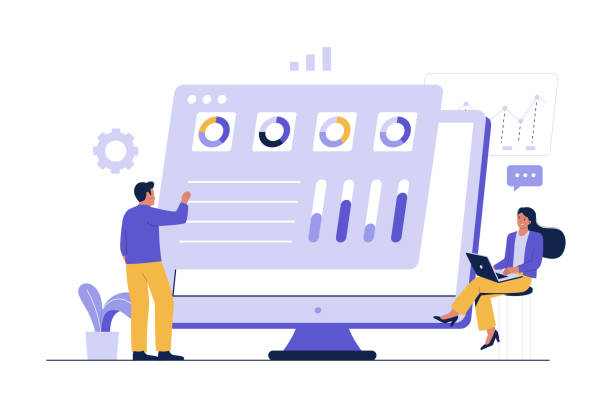
After implementing an #advanced_user_interface_design, measuring its efficiency and effectiveness is essential to ensure the achievement of business goals.
Only with accurate measurement can one correctly determine whether the investment made in modern UI website design has yielded a desirable return on investment (ROI) or not.
One of the most important metrics is the #conversion_rate.
By monitoring changes in conversion rates (such as purchase rate, registration, or download) after UI changes, the direct impact of the new design can be observed.
An increase in conversion rate signifies the design’s success in guiding users toward desired actions.
Other metrics also exist for measuring efficiency.
#Bounce_Rate, which indicates the percentage of visitors who leave the website after viewing only one page, is an important metric.
A good user interface should reduce the bounce rate.
Also, #Average_Session_Duration and #Pages_Per_Session indicate the level of user engagement and interaction with the site’s content.
An increase in these metrics indicates that users find the website content useful and engaging.
To collect this data, web analytics tools like Google Analytics can be used.
These tools provide precise information about user behavior, navigation paths, and drop-off points in conversion processes.
In addition to quantitative data, #qualitative_feedback from users is also of high importance.
Conducting usability tests, user interviews, and surveys can provide deep insights into the strengths and weaknesses of the design.
Questions such as “Was it easy to find the information needed?” or “Was the purchase process complicated?” can uncover hidden problems.
ROI in UI/UX design goes beyond merely increasing sales.
An excellent user interface can lead to #reduced_customer_support_costs, #increased_brand_loyalty, and #creation_of_sustainable_competitive_advantage.
For instance, clear navigation and quick answers to FAQs on the website can reduce the number of phone calls or support emails.
Ultimately, continuous measurement and iterative improvement based on data are key to ensuring the effectiveness of a modern UI website design and achieving the best ROI from it.
This analytical approach helps us make informed decisions based on evidence and data, rather than merely on assumptions.
Are your e-commerce website visitors leaving before making a purchase? Don’t worry anymore! With RasaWeb’s professional e-commerce website design services, solve the problem of converting visitors into customers forever!
✅ Significant increase in conversion rates and sales
✅ Unparalleled and attractive user experience
⚡ Contact us now for a free consultation!
Challenges in Implementing Modern UI Website Design: What Obstacles Lie Ahead?
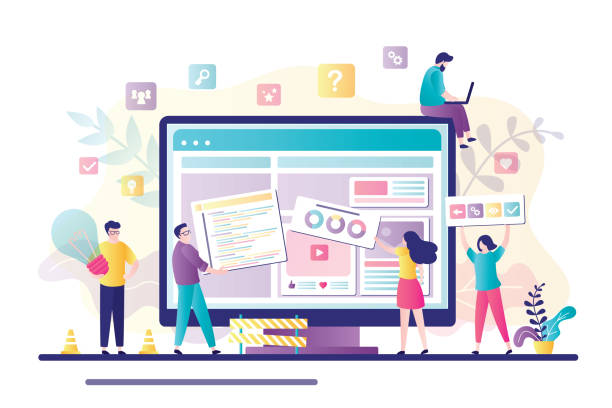
Implementing a #website_design with a #modern_user_interface, despite all its advantages, can come with #challenges and #obstacles that require careful planning and a strategic approach to overcome them.
One of the main challenges is #cost and #budget.
Designing and developing a modern user interface requires various specializations, including UX/UI designers, front-end and back-end developers, and SEO specialists, all of whom require significant financial investment.
Some businesses, especially small and medium-sized enterprises, may face difficulties in securing this initial budget.
Another challenge is #resistance_to_change.
This resistance can stem from both internal stakeholders (who are accustomed to the old UI and don’t fully grasp the benefits of change) and existing website users (who are dissatisfied with changes in how they interact with the site).
Managing this resistance requires #clear_communication and #explaining_the_benefits_of_change.
Educating and informing users and stakeholders can help reduce this resistance.
Also, #technical_and_technological_limitations can hinder the creation of a modern design.
Older websites may run on outdated platforms or Content Management Systems (CMS) that lack the flexibility required to implement complex and responsive designs.
In such cases, a complete website redesign or migration to newer technologies may be necessary, which itself is a time-consuming and costly process.
#Finding_a_specialized_and_experienced_team is also a significant challenge.
Given the rapid pace of change in web design, hiring designers and developers familiar with the latest trends, tools, and best practices is difficult.
The job market for these specialists is competitive, and attracting the right individuals can be time-consuming.
Also, the issue of #balancing_aesthetics_and_performance is always present.
A website might be visually very appealing, but if it has slow loading speed or complex navigation, it quickly loses users.
Modern UI website design requires finding the right balance between visual appeal and optimal performance.
Finally, maintaining #Accessibility_standards for all users, including those with disabilities, is an ethical and legal challenge that requires special attention.
Overcoming these challenges requires a comprehensive approach, careful planning, and a commitment to continuous improvement.
Why Investing in Modern UI Website Design is a Necessity?

In today’s digital world, where the competition for user attention is fiercer than ever, investing in #website_design with a #modern_user_interface is no longer a choice but a #strategic_necessity for the survival and growth of any business.
Several reasons justify this necessity, collectively indicating a significant return on investment derived from this approach.
The first and most important reason is #User_Experience (UX).
Today’s users strongly avoid websites that offer a poor user experience.
A modern user interface provides a smooth, intuitive, and enjoyable interaction, leading to increased user satisfaction, longer site visits, and reduced bounce rates.
This satisfaction, in turn, helps increase customer loyalty and repeat visits.
The second reason is #competitive_advantage.
In a market with dozens or hundreds of competitors, your website must stand out.
A modern UI website design can distinguish you from competitors and demonstrate your brand’s professionalism and modernity.
This difference is the first thing that grabs the attention of new users and can persuade them to choose you over competitors.
Furthermore, the positive impact on #SEO is undeniable.
Search engines place great importance on user experience factors such as loading speed, responsiveness, and easy navigation.
Websites with modern UIs generally perform better on these factors and consequently achieve higher rankings in search results, which means greater visibility and more organic traffic.
The third reason is #increased_conversion_rate.
The ultimate goal of many websites is to convert visitors into customers, subscribers, or leads.
A well-designed user interface makes conversion paths clear and simple, removes obstacles, and guides users toward desired actions.
Clear calls-to-action, simple forms, and frictionless payment processes are all elements of a modern UI that contribute to increased conversion rates.
Ultimately, investing in #modern_UI_design means investing in the future.
With technological advancements and changing user expectations, websites that are not up-to-date in design quickly become obsolete and inefficient.
A proactive approach to design helps you keep pace with changes and leverage the full potential of your online presence.
This approach highlights the vital importance of modern UI website design in achieving business goals and maintaining competitiveness in today’s digital ecosystem.
Frequently Asked Questions
| Question | Answer |
|---|---|
| What is modern UI website design? | It’s an approach to website design that focuses on clean aesthetics, simplicity, high usability, and providing a visual and pleasant user experience (UX). |
| What are the key elements of a modern web interface? | Flat Design, smart use of whitespace, attractive typography, intuitive navigation, quality images, and responsiveness are key elements. |
| Why is using a modern UI important in website design? | It attracts and retains users, increases brand credibility, improves conversion rates, and provides a smooth and pleasant user experience. |
| How does a modern User Interface (UI) affect User Experience (UX)? | A modern UI directly improves the user experience by creating a beautiful, organized, and understandable environment, making interaction easier. |
| What is the role of typography in modern UI design? | Typography is crucial for readability, creating information hierarchy, conveying brand mood, and the overall visual appeal of the site. |
| How does Responsive Design relate to modern UI? | Responsive design is an integral part of modern UI, as it ensures the site’s appearance and functionality are consistent and optimal across all devices (mobile, tablet, desktop). |
| What are the current trends in modern web UI design? | Dark Mode, subtle animations, creative use of whitespace, prominent typography, and the use of asymmetrical graphic elements are among recent trends. |
| How can one ensure a modern UI has high usability? | By conducting user testing, simplifying navigation, providing clear Calls to Action (CTAs), improving loading speed, and focusing on Accessibility. |
| What is the main difference between UI and UX in modern design? | UI is the look and feel of the site (user interface), while UX is the overall user experience when interacting with the site. UI is considered a part of UX. |
| What tools are used for modern web UI design? | Common tools like Figma, Sketch, Adobe XD, Photoshop, and Illustrator are used for modern UI design and prototyping. |
And other advertising services of RasaWeb Advertising Agency
Smart Google Ads: A combination of creativity and technology for improving SEO ranking through proprietary programming.
Smart Website Development: A dedicated service for online growth based on precise audience targeting.
Smart Brand Identity: A professional solution for analyzing customer behavior with a focus on marketing automation.
Smart UI/UX: A combination of creativity and technology for improving SEO ranking through proprietary programming.
Smart Sales Automation: An innovative platform for improving campaign management with marketing automation.
And over a hundred other services in the field of internet advertising, advertising consultation, and organizational solutions
Internet Advertising | Advertising Strategy | Advertorials
Sources
- The Importance of UI and UX in Website Design
- What is User Interface and User Experience and Why is it Important?
- Principles of UI and UX Design in Digital Marketing
- Why is User Interface Design Important?
? Ready for sustainable brilliance and growth in the digital world? RasaWeb Afarin Digital Marketing Agency, with its expertise in providing comprehensive services including SEO-optimized website design, Search Engine Optimization (SEO), and targeted advertising campaigns, is your reliable partner on the path to online success.
📍 Tehran, Mirdamad Street, next to Bank Markazi, Southern Kazeroon Alley, Ramin Alley, No. 6

